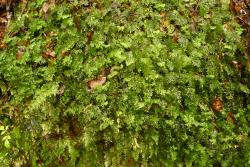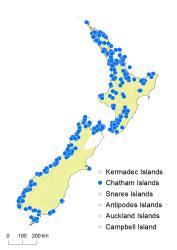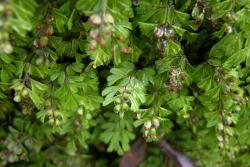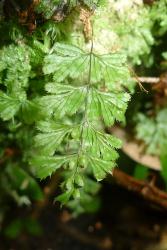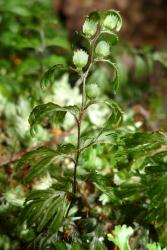- = Hymenophyllum zeelandicum Bosch, Ned. Kruidk. Arch. 5(3): 175 (1863)
- = Hymenophyllum pusillum Colenso, Trans. & Proc. New Zealand Inst. 12: 365 (1880) nom. illeg., non Hymenophyllum pusillum Schott 1859
Epiphytic, terrestrial or rupestral ferns. Rhizomes long-creeping, c. 0.2 mm diameter, bearing very scattered red-brown hairs up to 0.5 mm long, clustered at bases of stipes. Fronds 11–100 mm long. Stipes 2–35 mm long, dark brown throughout, not winged, glabrous or bearing very scattered hairs. Laminae 1-pinnate-pinnatifid to 1-pinnate-bipinnatifid, elliptic or narrowly elliptic or rarely ovate, 7–70 mm long or rarely up to 100 mm in attenuate forms, 6–30 mm wide, light green, membranous, bearing scattered hairs on costae and especially at bases of indusia. Rachises narrowly winged only in distal half, brown, bearing scattered hairs; rachis wings planate, margins entire. Primary pinnae in 1–15 pairs, not overlapping; distal portion of primary pinnae straight or slightly incurved acroscopically; distal primary pinnae ovate or elliptic or obovate, winged throughout, adnate; proximal primary pinnae ovate, or elliptic or broadly elliptic, winged in distal half, stalked; the longest primary pinnae at or below the middle, 4–19 mm long, 3–10 mm wide. Ultimate lamina segments mostly arising acroscopically but at least some basiscopically on primary pinnae, oblong or elliptic, up to 6 mm long, 0.8–2.0 mm wide; apices obtuse or truncate; margins markedly toothed, lacking a distinct border; segments on primary pinnae mostly curved towards frond apex. Sori borne on short acroscopic segments at the base of primary pinnae, solitary on each segment, 1 on each primary pinna, adnate; indusia bivalvate; indusial flaps ovate or elliptic or almost orbicular, 1.5–2.5 mm long, apices obtuse or truncate, margins deeply toothed, outer surfaces sometimes hairy at base; receptacles included within indusial flaps or rarely slightly exserted.
Hymenophyllum revolutum is one of several small filmy ferns in New Zealand with toothed margins. It is smaller than either H. bivalve or H. multifidum, and lacks the marginal spines on the lamina segments in H. armstrongii or the spines on the outer surfaces of the indusial flaps in H. minimum. It is very similar to H. peltatum and H. cupressiforme, but distinguished by its rachises which are winged only in the distal half and its indusial flaps which are strongly toothed. It is further distinguished from H. peltatum by having a single sorus on each primary pinna rather than up to three, and by its secondary lamina segments which arise basiscopically as well as acroscopically. Small sterile fronds may be confused with those of H. minimum but are usually at least pinnate-pinnatifid rather than pinnate.
North Island: Northland, Auckland, Volcanic Plateau, Gisborne, Taranaki, Southern North Island.
South Island: Western Nelson, Sounds-Nelson, Westland, Canterbury, Otago, Southland, Fiordland.
Chatham Islands, Stewart Island.
Altitudinal range: 0–1000 m.
Hymenophyllum revolutum occurs in lowland and montane areas throughout the North Island from Cape Reinga southwards except for the east coast. It ranges from sea level to 900 m in the Ruahine Ranges and just over 1000 m on Mt Taranaki, although it is mostly found below 750 m. In the South Island it occurs in lowland and montane areas of the Marlborough Sounds, north-west Nelson, Westland, Fiordland and Southland as far east as the Catlins, with outlying populations around Dunedin and on Banks Peninsula. It reaches 800 m in the Edith Valley, Fiordland.
Occurs under kauri, podocarp, beech and broadleaved forest, in kānuka and mānuka scrub and rarely in subalpine scrub, growing on the ground, on damp moss-covered banks and rocks, on rotten logs and stumps, at the base of tree trunks and as an epiphyte. It has been recorded growing on Cyathea dealbata, C. medullaris, C. smithii, Dicksonia squarrosa, Cordyline australis, Dacrydium cupressinum, Metrosideros excelsa, Myrsine salicina, Pseudopanax chathamicus, Weinmannia racemosa and species of Nothofagaceae.
n = 22 (Brownlie 1958).
The name Hymenophyllum tunbridgense (L.) Sm., a species of western Europe, has been widely misapplied to this species.
Hymenophyllum revolutum was described by Colenso (1845) from collections he made on the shores of Lake Waikaremoana in December 1841. The lectotype was chosen by Allan (1961), citing "WELT, Colenso" (now WELT P003270). There are also syntype specimens at K (Colenso 276 – photo WELT E468/28) and in the Cheeseman Herbarium (AK 128411).
Hymenophyllum zeelandicum was described by Bosch (1863) from specimens collected by J.D. Hooker at the Bay of Islands, and by Wilkes in New Zealand. No original material was located in L, identified as Bosch’s main herbarium by Stafleu & Cowan (1976). However, a specimen in K, indentified by Bosch, has been designated as lectotype by Brownsey & Perrie (2016).



